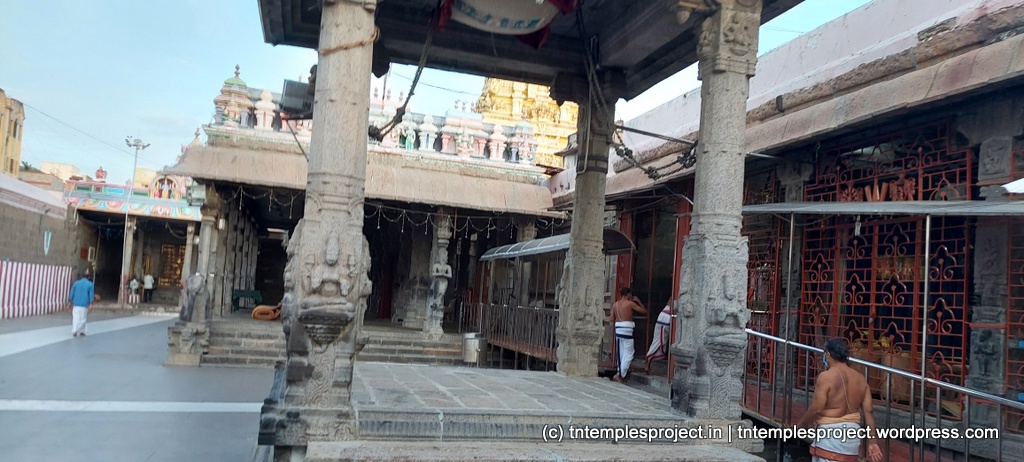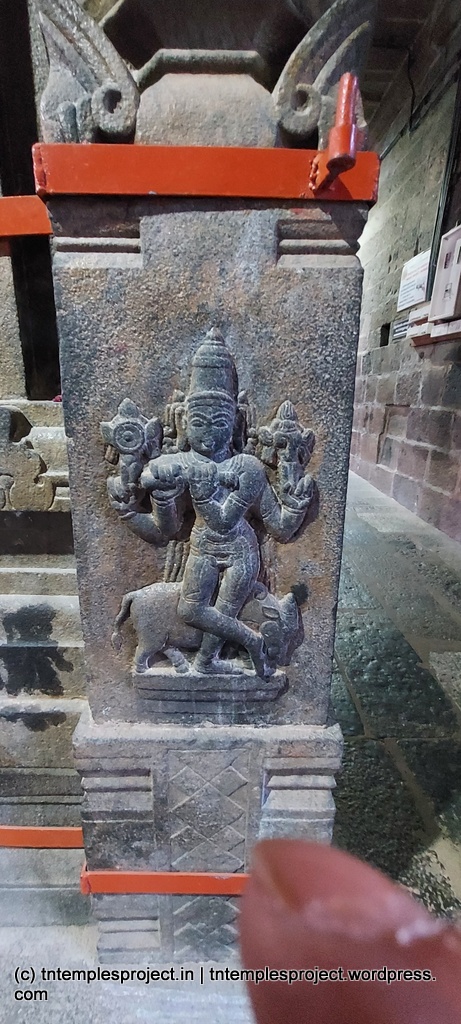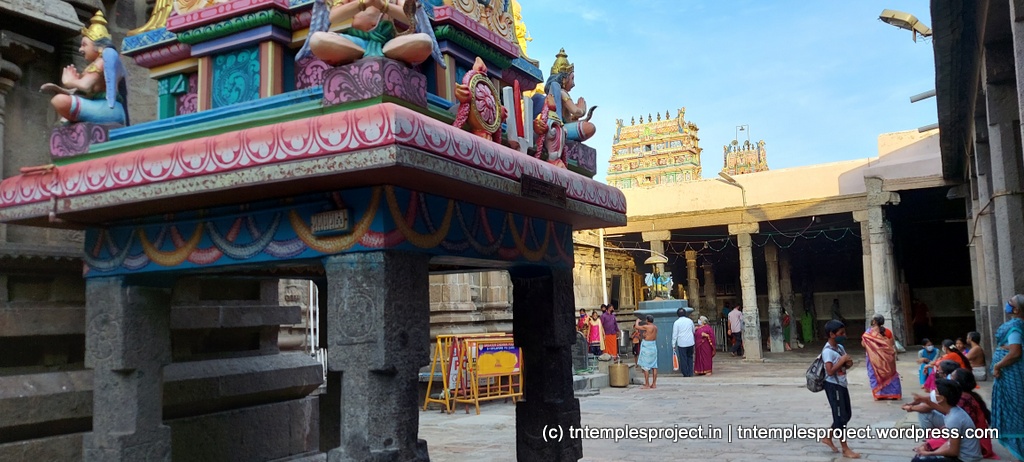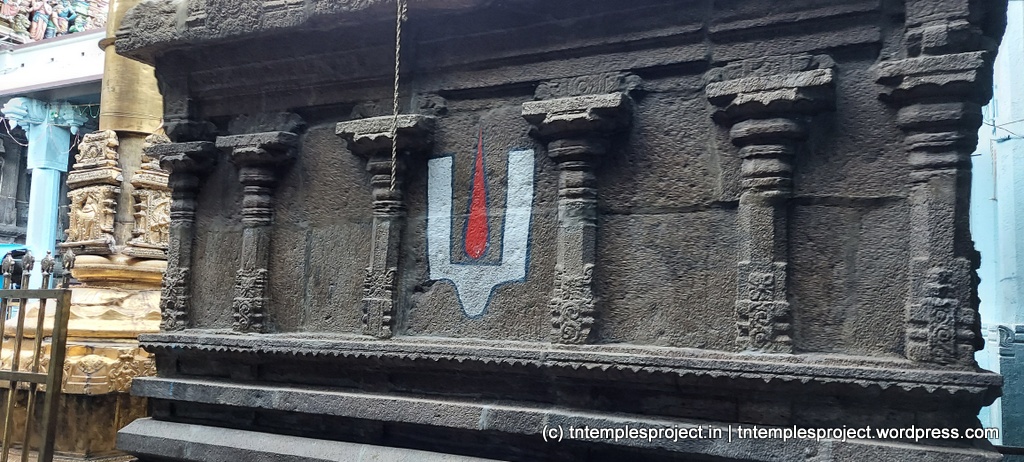Basic information about the temple
| Moolavar: | Parthasarathy Perumal | Ambal / Thayar: | Rukmani |
| Deity: | Perumal | Historical name: | Tiruallikeni |
| Vriksham: | Teertham: | ||
| Agamam: | Age (years): | Timing: | 6 to 12.30 & 4 to 9 | Parikaram: |
| Temple group: | Divya Desam | – | |
| Sung by: | Temple set: | ||
| Navagraham: | Nakshatram: | ||
| City / town: | Triplicane | District: | Chennai |
| Maps from (click): | Current location | Chennai (4 km) | Tiruvallur (52 km) |
| Kanchipuram (84 km) | Vellore (156 km) |
Location
Sthala puranam and temple information
There are so many fascinating aspects and stories about this temple, that it is not possible to cover all of them. So, we take a look at some of the more interesting ones here.

Sage Brighu had a daughter named Vedavalli (who was in fact Lakshmi in human form) who he found in a lotus (alli) flower. The sage desired to see his daughter married off to Lord Vishnu, and so worshipped the Lord for this. Vishnu descended to Bhulokam to make his devotee happy, and married Vedavalli, here.
Various aspects of Krishna in the Mahabharatam – particularly the war – are brought out in vivid and nuanced detail in the temple, particularly in the iconography of the moolavar. During the Kurukshetra war, Krishna promised not to fight and, by extension, not to bear weapons; and so, Parthasarathy Perumal does not have his chakram (discus) at this temple. This theme continues. Interestingly, the moolavar – who is depicted standing, with a knife tucked by His hip – sports a moustache on most days. Perumal’s face is also pock-marked – apparently an indication of the many arrows that struck Him during the war at Kurukshetra. In another episode from the war, an arrow released by Bhishma struck Krishna on his big toe, and so the moolavar’s murti here is depicted missing that toenail! The Utsavar is also depicted in the same theme, sporting a charioteer’s stick instead of His mace. Perumal also has what looks like a scar, on His hip, which is explained as the scar caused when Yashodha tied a rope around Him as a child, to stop Him from stealing butter!
According to another sthala puranam, this place used to be a forest of Tulasi (Brinda) plants. A king named Sumati wished to see and worship Vishnu in His form as Parthasarathy from the Mahabharatam. But he was unable to even travel to Brindavanam in the nort, where Krishna lived and grew up at one time. So, he worshipped Srinvasa Perumal at Tirupati to have his wish fulfilled. The king heard a voice – that of Srinivasa Himself – telling him to come to Brindaranyam – this place, where there was already a temple for Parthasarathy, built by Sage Atreya.

Tiruvallikeni or Allikeni is the historical and the Tamil name of this place (corrupted / anglicised to Triplicane), meaning lily (alli) pond (keni). The specific type of lotus is called Kairavini in Sanskrit, and this is also the name of the main tank of the temple, the Kairavini Pushkarini.
This temple is referred to as a Pancha Murti sthalam, as it has shrines for Vishnu in five different forms – Venkatakrishnar (Parthasarathy) in the garbhagriham, Ranganathar and Rama (in the front mandapam), and Gajendra Varadar and Yoga Narasimhar (in the prakaram). Vishnu is also depicted as Varaha in the garbhagriham, making Three of the 12 azhvars – Peyazhvar, Tirumazhisaiazvhar and Tirumangaiazvhar – have sung on Perumal here.
In addition to the moolavar, there are also shrines depicting Vishnu of five other Divya Desam temples – Venkatesa Perumal / Srinivasa at Tirupati, Ranganathar of Srirangam, Varadaraja Perumal of Kanchipuram, Rama of Ayodhya and Narasimhar of Ahobilam. The Yoga Narasimhar temple is part of the temple complex, but is a separate west-facing temple, complete with its own dhwajasthambam and bali peetham. Also, during the temple’s annual Brahmotsavam, the temple chariot / car runs twice – once for Parthasarathy Perumal and once for Yoga Narasimhar.
An interesting practice here is to offer sweet Pongal and with significantly more ghee than normal, as neivedyam for Parthasarathy Perumal. The belief is that this helps give relief to, and cure, His injuries! Conversely, since Narasimhar is in yoga-nishtha, salt-and-pepper-based offerings are made to Him.
Originally built by the Pallavas in the 8th century, this temple was later expanded by the Cholas, and then the Vijayanagara dynasty in the 15th century. As a result, the temple as it stands today is comprised of many different structures from varying time periods. The small four-pillared mandapam in the front is from the time of the Vijayanagara dynasty, while the 32-pillar mandapam was constructed in the mid-19th century by Mannivakkam Somasundaram Mudalaiyar. The compound wall is from the mid-16th century, built by a person named Narasinga Dasan. Other parts of the temple too have been dated, except the Raja Gopuram, whose only indications of antiquity are that it must be over 500 years old.

In addition to the moustache sported by the moolavar, the other unusual feature in the garbhagriham is that Krishna is depicted with His consort Rukmini, as also Balarama, Pradyumna, Aniruddha and Satyaki – making this a family portrait of sorts!
Inscriptions in the temple refer to the Pallava kings Nandivarman Dantivarman (8th century), and Tirumangaiazhvar also refers to this temple as having been built by the Pallavas. Chola period inscriptions are there as well.
Other Information for your visit
Tirunangur near Mayiladuthurai is home to 11 Ekadasa Divya Desam temples, each representing a form of Perumal from another Divya Desam temple. One of these is the Parthanpalli Parthasarathi Perumal temple, where He is present as Parthasarathy of Tiruvallikeni.
In the past, there have been conflicts between the Thenkalai and Vadakalai sects of Vaishnavites, over each of their rights to worship and recite hymns and verses. This goes back to British times.
The Tamil poet Subramania Bharati used to regularly feed coconuts to the temple elephant, but one day in 1921, the elephant attacked him, injuring him quite badly. This led to a deterioration to his already poor health, causing the poet’s death in September 1921.
Contact
Gallery





























